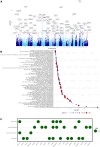Genome-wide meta-analysis conducted in three large biobanks expands the genetic landscape of lumbar disc herniations
- PMID: 39511132
- PMCID: PMC11544010
- DOI: 10.1038/s41467-024-53467-z
Genome-wide meta-analysis conducted in three large biobanks expands the genetic landscape of lumbar disc herniations
Abstract
Given that lumbar disc herniation (LDH) is a prevalent spinal condition that causes significant individual suffering and societal costs, the genetic basis of LDH has received relatively little research. Our aim is to increase understanding of the genetic factors influencing LDH. We perform a genome-wide association analysis (GWAS) of LDH in the FinnGen project and in Estonian and UK biobanks, followed by a genome-wide meta-analysis to combine the results. In the meta-analysis, we identify 41 loci that have not been associated with LDH in prior studies on top of the 23 known risk loci. We detect LDH-associated loci in the vicinity of genes related to inflammation, disc-related structures, and synaptic transmission. Overall, our research contributes to a deeper understanding of the genetic factors behind LDH, potentially paving the way for the development of new therapeutics, prevention methods, and treatments for symptomatic LDH in the future.
© 2024. The Author(s).
Conflict of interest statement
The authors declare no competing interests.
Figures





References
-
- Fardon, D. F. et al. Lumbar disc nomenclature: version 2.0. Spine J.14, 2525–2545 (2014). - PubMed
-
- Dower, A., Davies, M. A. & Ghahreman, A. Pathologic basis of lumbar radicular pain. World Neurosurg.128, 114–121 (2019). - PubMed
-
- Cosamalón-Gan, I. et al. Inflammation in the intervertebral disc herniation. Neurocirugia (Engl. Ed.)32, 21–35 (2021). - PubMed
-
- Patel, E. A. & Perloff, M. D. Radicular pain syndromes: cervical, lumbar, and spinal stenosis. Semin Neurol.38, 634–639 (2018). - PubMed
Publication types
MeSH terms
Supplementary concepts
LinkOut - more resources
Full Text Sources
Medical

